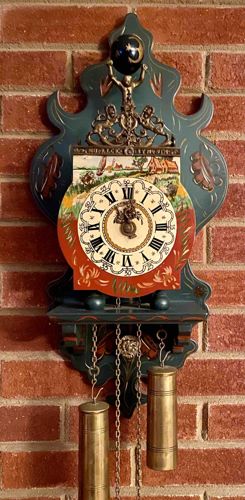
German/Black Forest Style Weight-Driven Wall Clock
This item is an ornate, weight-driven wall clock, primarily constructed from painted wood and metal components. Its design strongly evokes traditional German or Alpine folk art, commonly associated with the Black Forest region, suggesting an estimated age from the late 19th to mid-20th century. The main structure consists of a shapely, dark teal or blue-green painted wooden backboard, featuring gracefully cut-out edges and subtle, lighter-toned painted leaf or swirl motifs along its borders. At the very top, a striking dark sphere with a crescent moon and star design is prominently placed. Beneath this, a robust and intricate metal finial, likely crafted from brass or bronze with a darkened, aged patina, serves as a significant decorative element. This finial depicts a classical figure, possibly Atlas or a similar deity, holding aloft the sphere, flanked symmetrically by two regal lion figures. This detailed metalwork adds considerable visual weight and historical character to the clock's upper section. The central focus is the circular clock face, presented in a crisp white or cream color with bold, black Roman numerals (I through XII) and a finely detailed dotted minute track. The ornate brass-toned clock hands are period-appropriate for such a piece. The clock face is beautifully integrated into a lower segment of a vibrant, hand-painted landscape scene. This pictorial element skillfully depicts traditional European countryside motifs, including windmills, charming cottages, and small figures, creating a pastoral tableau. The entire painted section is further framed at its bottom by a segment of rich red paint, adorned with delicate white painted swirls and floral designs, which harmoniously complements the dark teal of the main body. Below the main timekeeping section, a small, integrated shelf-like projection from the wooden frame features two dark, spherical ornaments that subtly echo the form of the top finial. From this lower section hang two substantial, cylindrical brass-toned weights, suspended by delicate metal chains. A third chain is also visible, typically indicating the presence of a pendulum mechanism, although the pendulum bob itself is not fully visible in the image. The materials appear to be in generally good condition, exhibiting a natural patina on the metal components consistent with their age. There is some minor visible wear or superficial scuffing on the painted wooden surfaces, particularly along raised edges, which indicates natural aging and handling, but no major structural damage such as cracks or significant chipping is readily apparent. The overall craftsmanship suggests a well-made and highly decorative piece, serving both as a functional timepiece and an aesthetic adornment.
AI-Generated Appraisal Disclaimer
Estimated Value
$800 - $1,500
Basic Information
Category
Wall Clock
Appraised On
December 7, 2025
Estimated Value
$800 - $1,500
Item Description
This item is an ornate, weight-driven wall clock, primarily constructed from painted wood and metal components. Its design strongly evokes traditional German or Alpine folk art, commonly associated with the Black Forest region, suggesting an estimated age from the late 19th to mid-20th century. The main structure consists of a shapely, dark teal or blue-green painted wooden backboard, featuring gracefully cut-out edges and subtle, lighter-toned painted leaf or swirl motifs along its borders. At the very top, a striking dark sphere with a crescent moon and star design is prominently placed. Beneath this, a robust and intricate metal finial, likely crafted from brass or bronze with a darkened, aged patina, serves as a significant decorative element. This finial depicts a classical figure, possibly Atlas or a similar deity, holding aloft the sphere, flanked symmetrically by two regal lion figures. This detailed metalwork adds considerable visual weight and historical character to the clock's upper section. The central focus is the circular clock face, presented in a crisp white or cream color with bold, black Roman numerals (I through XII) and a finely detailed dotted minute track. The ornate brass-toned clock hands are period-appropriate for such a piece. The clock face is beautifully integrated into a lower segment of a vibrant, hand-painted landscape scene. This pictorial element skillfully depicts traditional European countryside motifs, including windmills, charming cottages, and small figures, creating a pastoral tableau. The entire painted section is further framed at its bottom by a segment of rich red paint, adorned with delicate white painted swirls and floral designs, which harmoniously complements the dark teal of the main body. Below the main timekeeping section, a small, integrated shelf-like projection from the wooden frame features two dark, spherical ornaments that subtly echo the form of the top finial. From this lower section hang two substantial, cylindrical brass-toned weights, suspended by delicate metal chains. A third chain is also visible, typically indicating the presence of a pendulum mechanism, although the pendulum bob itself is not fully visible in the image. The materials appear to be in generally good condition, exhibiting a natural patina on the metal components consistent with their age. There is some minor visible wear or superficial scuffing on the painted wooden surfaces, particularly along raised edges, which indicates natural aging and handling, but no major structural damage such as cracks or significant chipping is readily apparent. The overall craftsmanship suggests a well-made and highly decorative piece, serving both as a functional timepiece and an aesthetic adornment.
Get Your Items Appraised
Instant estimates of your treasures with AI-powered instant appraisals